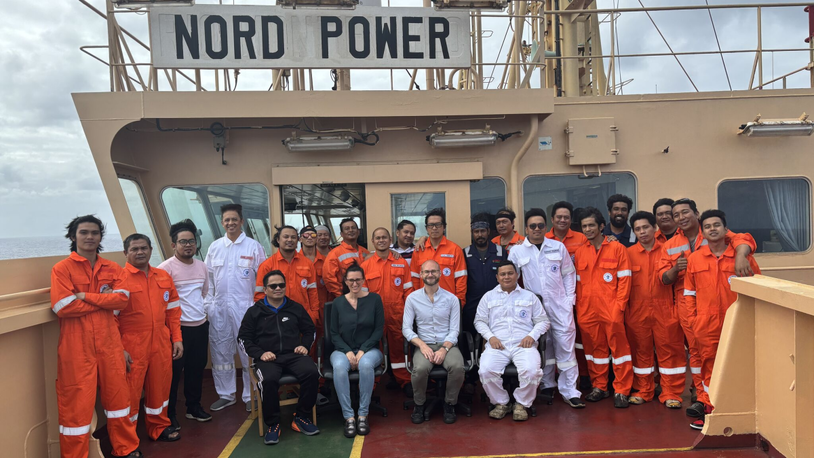Business Sectors
Events
Contents
Register to read more articles.
Adopting new clean tech remains challenging for shipowners
A lack of collaboration and transparency on green technology performance has been a key barrier to its uptake, says Houlder strategy consultant Sean McLaughlin
One of major challenge in meeting international shipping’s decarbonisation goals is the slow pace in adopting new clean technologies. According to a recent survey of shipowners, conducted by Houlder,
the uptake of new clean technologies has been slowed by a lack of collaboration between the owners themselves, as well as with their technology providers. To compile the survey, Houlder interviewed senior executives in the container, bulker, cruise and ferry sectors, anonymising the information into a whitepaper, Clean technology and the decarbonisation challenge.
Survey findings
There is a perceived lack of independent corroboration for the claims made by some technology vendors, and some shipowners point to disappointing adoptions, according to the survey. While the equipment may perform as the manufacturer intended, it does not always deliver the savings claimed and sometimes comes with a significant increase in opex.
None of the participants accused technology providers of deliberately misleading, results but reflected that the data in a brochure will inevitably relate to another ship. Additionally, while there are a lot of operational and technological solutions available for meeting the more immediate decarbonisation goals, such as IMO’s Carbon Intensity Indicator (CII) regulations, getting new technologies onboard and commissioned can be challenging. A ship is a system and applying an additional component to that system can result in unintended consequences.
“There is a perceived lack of independent corroboration for the claims made by some technology vendors”
Those who charter ships on the spot market observed that they found it difficult to risk investments that would substantially increase their day rates. They said a discussion on a long-term charter can be significantly aided by showing a high environmental performance at the outset, coupled with a plan to invest over the life of the charter.
In contrast, a vessel sold on spot gets much less benefit and usually it is the cheapest ship that wins.
The discussion about clean technologies is often framed around retrofits, leaving the discussion about future fuels linked to newbuilds. The fact that future fuels have been estimated to be two to 10 times more expensive than legacy fuels, plus their significantly reduced volumetric energy density, was unsurprisingly raised in most of our discussions and linked to the need to take radical clean technology thinking into the newbuild environment as well.

Collaboration is key
There was unanimous support that collaboration must play a big part in creating the shipping fleet of the future. This need is of particular importance for those owners with smaller fleets, which lack the luxury of an in-house R&D team. Participants did however feel there needs to be a more proactive, practical and innovative approach than simply relying on everyone dropping their competitive aims.
There is a need for more independent, industry-wide conveners to facilitate project collaboration. Flag states, industry coalitions, financial institutions and independent consultants can fulfil this role. National and international chambers, for example, already disseminate information and lobby on behalf of their members, but they could also become proactive convenors for projects which could be a particular benefit to their smaller members.
Independent advisors can also help shipowners manage the requirements of financiers and other stakeholders. They can provide background collaboration by applying their breadth of knowledge and experience to support shipowners evaluating fleet transition (retrofits and newbuilds) strategies and by helping them manage the requirements of financiers and other stakeholders. They can provide independent analysis of the benefits of specific clean technologies, individually or combined with others, or new fuels. This involves identifying opportunities that suit specific vessels (engines, fuels, other equipment) and helping shipowners benchmark and measure the gains they make by adopting these technologies. Operationally, they can evaluate the short- and long-term viability of proposed clean technology strategies, monitor international and regional developments relating to regulations and new fuels, and help manage the timing of newbuild and retrofit projects to minimise operational disruption.
“Future fuels have been estimated to be two to 10 times more expensive than legacy fuels”
Clean technology is often cost and time efficient to install, especially when compared to alternative fuel capabilities. A significant proportion of clean technology can be fitted without taking the vessel out of service, or quickly installed at a scheduled drydocking. However, one owner pointed out that there will be increasing pressure on drydock availability, with the need for extended or more frequent docking to fit new technologies. He observed that those owners which seek to leave their decisions on retrofits for as long as possible may find it hard to catch up when drydocks are full.
Investing now complex
Some 10 years ago, the business case for an investment was, in comparison to today, fairly straightforward. Now, the inputs to that assessment extend beyond the straightforward comparison of investment and direct financial return. They need to include the wider commercial impact of greenhouse gas emissions and other environmental abatements, and, importantly, have an eye to the reporting and cost implications of future regimes, such as the European ETS, the EU Taxonomy and many more.
This is daunting, but it also provides opportunities for shipowners to differentiate themselves from their competitors. After all, the degree of change that the decarbonisation transition needs provides some of the biggest competitive advantages that shipping has seen for many years. Stepping up to the decarbonisation challenge means recognising that in many cases this is about revolution and new paradigms, rather than the slow evolution that shipping has been used to. Flag states, national chambers and the international chamber, industry coalitions and independent consultants all have a key role to play if these barriers are to be overcome.
Related to this Story
Women in Maritime Today: Elin Saltkjel says no day working in maritime is dull
Events
Maritime Environmental Protection Webinar Week
Cyber & Vessel Security Webinar Week
The illusion of safety: what we're getting wrong about crews, tech, and fatigue
Responsible Ship Recycling Forum 2025
© 2024 Riviera Maritime Media Ltd.














